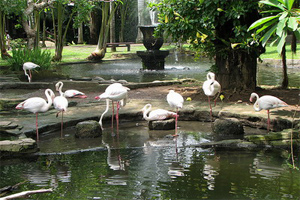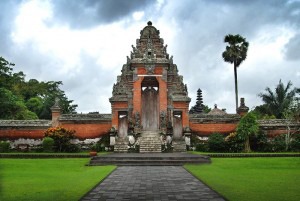 Bali is blessed with so many beautiful beaches around its island. It seems like every coastline in Bali is amazing and captivating. Of course not all beaches are famous, however some of these infamous beaches have a stunning beauty and unique characteristics that the others don’t have. One of these beaches is Kusamba Beach which is located in Kusamba Village, Dawan District, Klungkung Regency. This beach is approximately 7 km eastern of Semarapura Town; the capital of Klungkung. If you want to visit this beach you will need around 90 minute drive from Ngurah Rai International Airport, or take around 29 km route.
Bali is blessed with so many beautiful beaches around its island. It seems like every coastline in Bali is amazing and captivating. Of course not all beaches are famous, however some of these infamous beaches have a stunning beauty and unique characteristics that the others don’t have. One of these beaches is Kusamba Beach which is located in Kusamba Village, Dawan District, Klungkung Regency. This beach is approximately 7 km eastern of Semarapura Town; the capital of Klungkung. If you want to visit this beach you will need around 90 minute drive from Ngurah Rai International Airport, or take around 29 km route.
Kusamba Beach is surely amazing with shiny black sand and beautiful panorama also completed with natural and peaceful ambience. You will be able to see colorful boats decorating the beach line which are the property of the people from a fisherman village around here. This beach is quite popular for its persistent fishermen and its traditional sea salt farming. The fishermen and salt farmers here are still sticking to their inherited tradition for catching fish and creating salt. By promoting this beach as one of the tourism object in Klungkung, the local government hopes that the economy of this region can be raised. Tourists who come to this beach can directly observe the fishermen’s activities on the sea and sea salt farmers’ farming process right on the shore.
Early in the morning, the salt farmers have already started their farming activity. By using teku, some kind of sea water container made of palm stem, they walk down the beach to take sea water. After the teku is full, the sea water is splashed over the prepared sand area. They walk on the sand while shaking the teku-teku they carry on their shoulder. This process is repeated until all the area is wet by the sea water. Weather is an important factor in the process of traditional salt farming. The brighter the sun, the better the result will be. The heat of the sun will make the wet sand mixed well with the sea water. The catchment water which is already mixed well with the sand is then gathered in a bamboo container. The catchment water will drip from the bamboo into the prepared container. There are 2 containers with simple filtering system for the water. After that, these water will be dried under the sun to get the salt crystals.
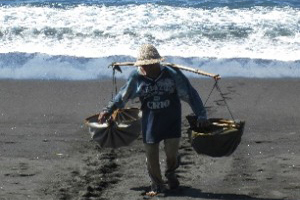 Besides fishing and salt farming, the people in Kusamba also do side jobs like ferrying daily needs like rice, seeds, or fruits to Nusa Penida, a deserted island across of Bali. Using big boat, they can deliver up to 1.5 ton goods to Nusa Penida. Besides that, they can also reach Nusa Lembongan, a small island near Nusa Penida. They usually cross from Banjar Tri Buanan Beach, Banjar Bias Beach, Kampung Islam Beach, with crossing time around 30 minutes until 2 hours depending on the boat that they use. Not just that, these boats can also carry the tourists who want to snorkeling and diving in those islands.
Besides fishing and salt farming, the people in Kusamba also do side jobs like ferrying daily needs like rice, seeds, or fruits to Nusa Penida, a deserted island across of Bali. Using big boat, they can deliver up to 1.5 ton goods to Nusa Penida. Besides that, they can also reach Nusa Lembongan, a small island near Nusa Penida. They usually cross from Banjar Tri Buanan Beach, Banjar Bias Beach, Kampung Islam Beach, with crossing time around 30 minutes until 2 hours depending on the boat that they use. Not just that, these boats can also carry the tourists who want to snorkeling and diving in those islands.
Segara Beach in Kusumba is also quite interesting because this beach is often used as traditional ritual place like nganyut which is still the series of ngaben ceremony. Besides that, around this beach there is also a fish market where various fresh fish with low prices can be gotten. If you want to visit this fish market, you must go here between 10.00 am until 4 pm.
Actually, there is no particular naming history of this beach. It was named Kusamba Beach just because this beach is located in Kusamba Village. However, if it is related to history, this beach has recorded as one historical place in the Indonesian Independence War. In 23 – 24 of May 1849he , Balinese troops were able to defeat Dutch armies. Moreover, Dutch important officer at that time, Lieutenant General Michiel was killed by the brave Balinese troops.
If you want to visit this beach you don’t need to worry because some public facilities for tourists have already built, such as restaurants, food stalls, parking area and boat rental for tourists who want to visit the other nearest islands. Kusamba Beach can be a good alternative if you are bored by the crowd of the other beaches in Bali. This beach offers tranquility, peaceful environment, and beautiful panorama for its visitors.

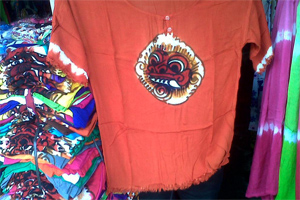
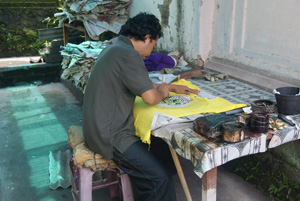 The first process of making colored barong shirt is sewing the fabrics according to the size needed by the market. After that, these shirts are going to be colored. They are tied, with the front and back parts are wrapped with plastic. That way is done to make a white circle pattern which will be the place for drawing barong. These wrapped parts of course will not be exposed by colors during the dyeing process, so these parts remain white. After the dyeing process is finished, the wrappers are opened, and then the shirts are washed and dried. After that, the shirts are ready to be given barong picture. Meanwhile, in the process of making white barong shirts, the barong picture can be directly drawn after the shirts are sewn based on the fix sizes. This kind of shirt’s production is faster and more efficient.
The first process of making colored barong shirt is sewing the fabrics according to the size needed by the market. After that, these shirts are going to be colored. They are tied, with the front and back parts are wrapped with plastic. That way is done to make a white circle pattern which will be the place for drawing barong. These wrapped parts of course will not be exposed by colors during the dyeing process, so these parts remain white. After the dyeing process is finished, the wrappers are opened, and then the shirts are washed and dried. After that, the shirts are ready to be given barong picture. Meanwhile, in the process of making white barong shirts, the barong picture can be directly drawn after the shirts are sewn based on the fix sizes. This kind of shirt’s production is faster and more efficient. 
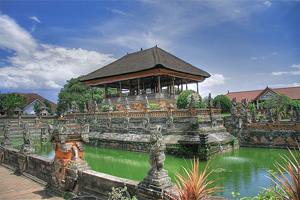
 Besides on the ceiling of Kerta Gosa, wayang paintings also decorates a building next to it called Bale Kambang. However, here in Bale Kambang, the paintings illustrate the story from Kakawin Ramayana and Sutasoma. This story theme gives us the clue that Bale Kambang main function is a place for human traditional ceremony (Manusa Yadnya), called Metatah or Mepandes for royal family.
Besides on the ceiling of Kerta Gosa, wayang paintings also decorates a building next to it called Bale Kambang. However, here in Bale Kambang, the paintings illustrate the story from Kakawin Ramayana and Sutasoma. This story theme gives us the clue that Bale Kambang main function is a place for human traditional ceremony (Manusa Yadnya), called Metatah or Mepandes for royal family.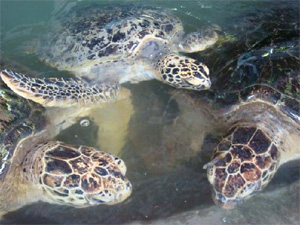
 Besides its wonderful landscape, Serangan Island also has a holy temple called Sakenan Temple. It is said that, this holy temple complex was built by Mpu Kuturan in the 12th Century and then continued by Danghyang Nirartha around the 15th Century. According to the legend, these two holy priests also got sira angen by the beauty and spiritual vibration of this island, so that a holy temple was built here. This temple possesses a unique architecture which is a bit similar to Luhur Uluwatu Temple on the southern tip of Bali Island. According to lontar (ancient document) “Usana Bali”, Sakenan Temple was firstly constructed by Mpu Kuturan in the era of Masula-Masuli (couple) Kingdom called Sri Dhana Dhirajalancana and Sri Dhana Dewiketu. The reign of this king was around 1178 until 1255.
Besides its wonderful landscape, Serangan Island also has a holy temple called Sakenan Temple. It is said that, this holy temple complex was built by Mpu Kuturan in the 12th Century and then continued by Danghyang Nirartha around the 15th Century. According to the legend, these two holy priests also got sira angen by the beauty and spiritual vibration of this island, so that a holy temple was built here. This temple possesses a unique architecture which is a bit similar to Luhur Uluwatu Temple on the southern tip of Bali Island. According to lontar (ancient document) “Usana Bali”, Sakenan Temple was firstly constructed by Mpu Kuturan in the era of Masula-Masuli (couple) Kingdom called Sri Dhana Dhirajalancana and Sri Dhana Dewiketu. The reign of this king was around 1178 until 1255.
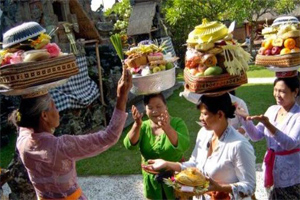
 For the tourists, this Makotek tradition will be very interesting to be visited if you are in Bali at Kuningan Day. Makotek / Ngrebeg tradition could only be seen in Munggu Village, Mengwi, Badung. This tradition is a kind of cultural legacy which have been done since the glorious era of Mengwi Kingdom who in the past conquered wide are including East Java. Reputedly, makotek was a celebration party for commemorating the victory of Mengwi Kingdom over Blambangan Kingdom from Banyuwangi, East Java. Until now, this tradition is still celebrated with purpose to ask for God’s blessing, health, and protection for Munggu Village itself. Makotek is celebrated every 6 month in Saniscara (Saturday) Wuku Kuningan which is the day of Kuningan.
For the tourists, this Makotek tradition will be very interesting to be visited if you are in Bali at Kuningan Day. Makotek / Ngrebeg tradition could only be seen in Munggu Village, Mengwi, Badung. This tradition is a kind of cultural legacy which have been done since the glorious era of Mengwi Kingdom who in the past conquered wide are including East Java. Reputedly, makotek was a celebration party for commemorating the victory of Mengwi Kingdom over Blambangan Kingdom from Banyuwangi, East Java. Until now, this tradition is still celebrated with purpose to ask for God’s blessing, health, and protection for Munggu Village itself. Makotek is celebrated every 6 month in Saniscara (Saturday) Wuku Kuningan which is the day of Kuningan.

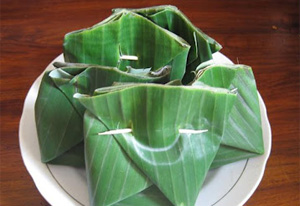 Soma (Monday), Pon, Wuku Dungulan, or 2 days before Galungan is the day for Sang Bhuta Dungulan to come to the earth tempting human to do vices even more. At this time, people will start to make “jaja” (traditional cake) which is also called “nyajaang”. Nyajaang could also mean to sincere.
Soma (Monday), Pon, Wuku Dungulan, or 2 days before Galungan is the day for Sang Bhuta Dungulan to come to the earth tempting human to do vices even more. At this time, people will start to make “jaja” (traditional cake) which is also called “nyajaang”. Nyajaang could also mean to sincere.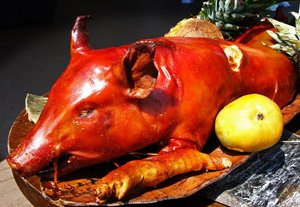 Anggara (Tuesday), Wage, Wuku Dungulan, or 1 day before Galungan is the day when Sang Bhuta Amangkurat strongly tempts human to do vice more than before. We are expected to be able to defeat the power of those three Bhutas (Bhuta Galungan, Bhuta Dungulan, and Bhuta Amangkurat). Symbolically, it is done by slaughtering pig or so called “nampah”. Nampah could also mean “nampa” or an act of sincerely welcome the arrival of Sanghyang Dharma or the God of Virtue. Pig is the symbol of laziness, so killing pig could also mean killing laziness natures.
Anggara (Tuesday), Wage, Wuku Dungulan, or 1 day before Galungan is the day when Sang Bhuta Amangkurat strongly tempts human to do vice more than before. We are expected to be able to defeat the power of those three Bhutas (Bhuta Galungan, Bhuta Dungulan, and Bhuta Amangkurat). Symbolically, it is done by slaughtering pig or so called “nampah”. Nampah could also mean “nampa” or an act of sincerely welcome the arrival of Sanghyang Dharma or the God of Virtue. Pig is the symbol of laziness, so killing pig could also mean killing laziness natures.

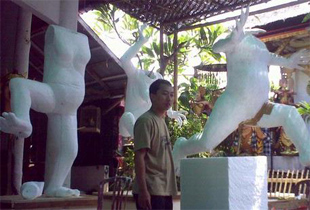
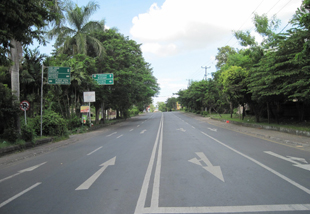



 Bali Bird Park or also known as “Taman Burung Bali” is located in Singapadu Village, Sukawati District, Gianyar, Bali. This bird and reptile park is one of the biggest in Indonesia and one of main attractions in Gianyar Regency. The location of this park is not too far from Denpasar City; about 12 km east with 40-60 minute travelling time. It is located in the area of wood and rock statues centre; Batubulan and the gold and silver handicraft centre; Celuk.
Bali Bird Park or also known as “Taman Burung Bali” is located in Singapadu Village, Sukawati District, Gianyar, Bali. This bird and reptile park is one of the biggest in Indonesia and one of main attractions in Gianyar Regency. The location of this park is not too far from Denpasar City; about 12 km east with 40-60 minute travelling time. It is located in the area of wood and rock statues centre; Batubulan and the gold and silver handicraft centre; Celuk.